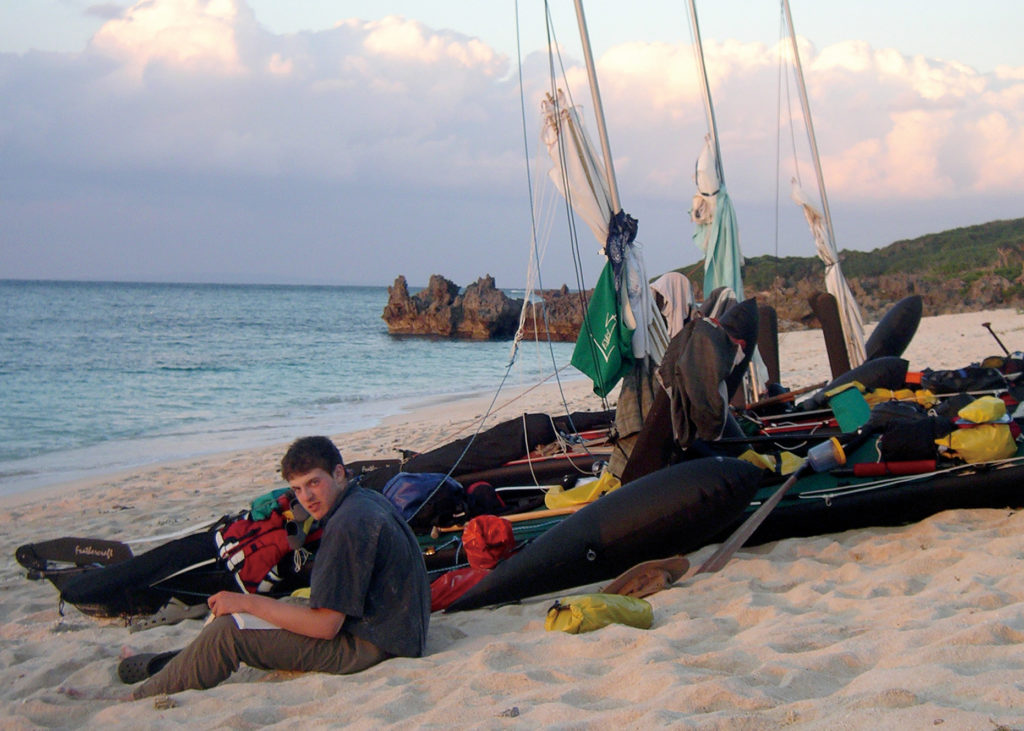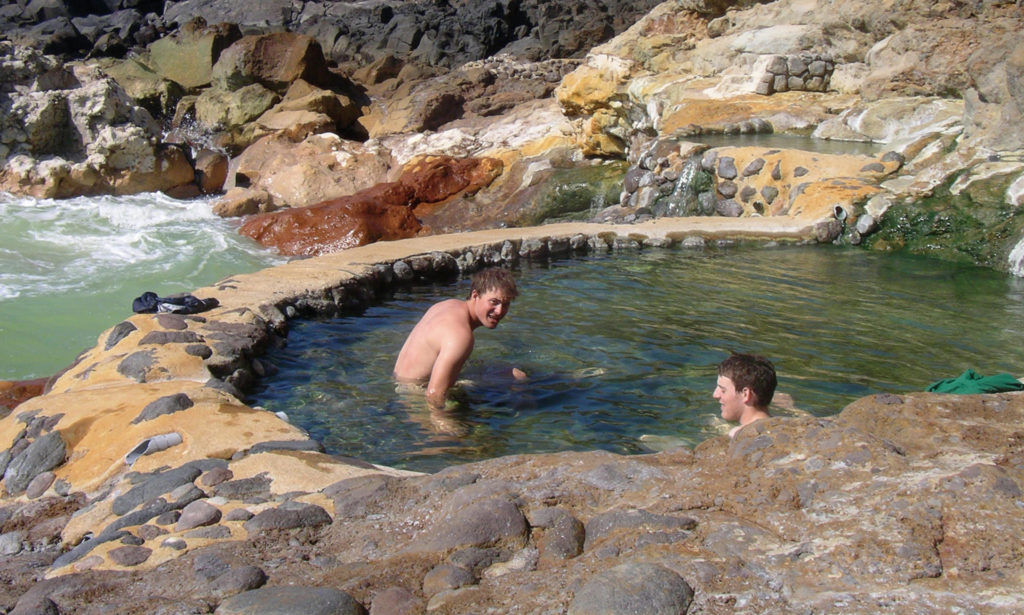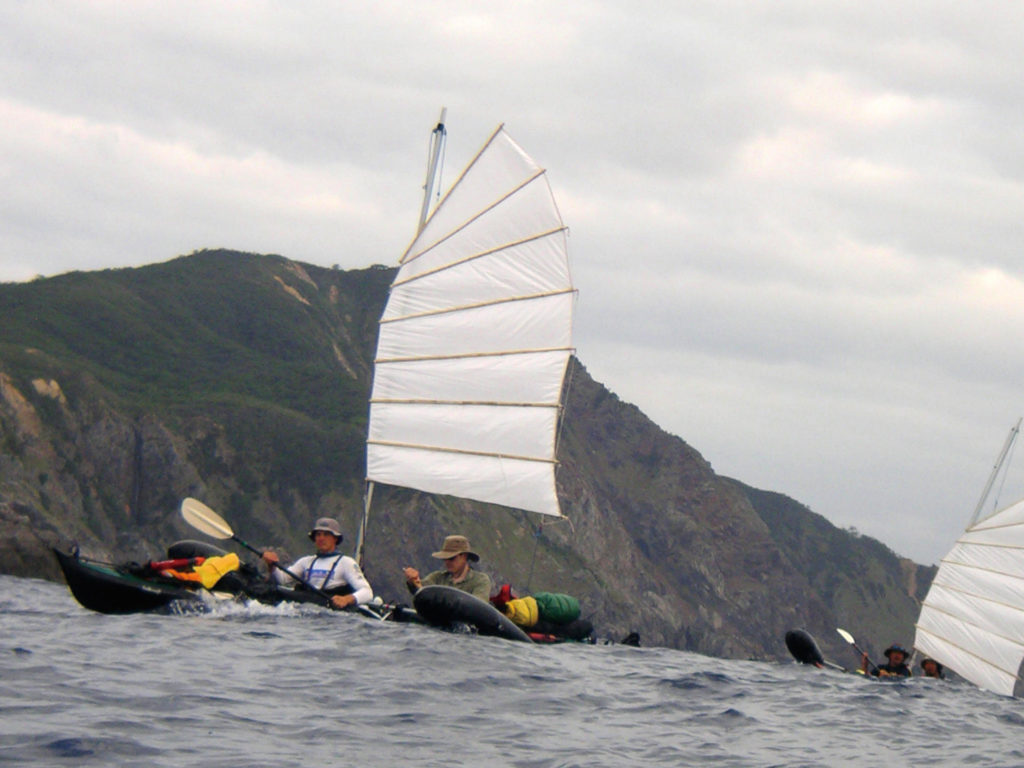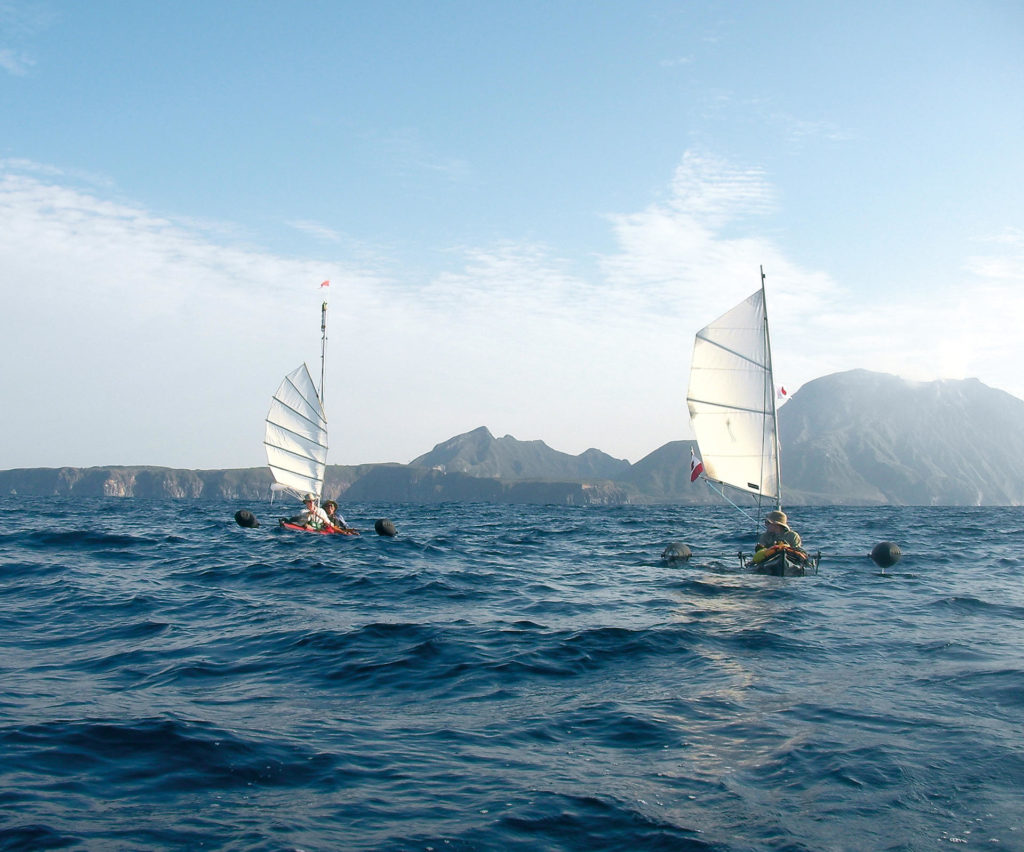I’ve come to Japan every year for the 20 years. But my latest trip was unlike all the rest. Our plan was to paddle and sail from southern Japan to northeast Taiwan, but like the seas we’ll cross, the plan is fluid and will undoubtedly be affected by circumstance. This much I’ve learned.

“Red skies at night – a sailor’s delight!” We had been camping and waiting on Sata Peninsula, the most southerly point of land of the four major islands of Japan, for a week. Super Typhoon Krosa, a full category five hurricane, blew by to the south, sending us huge waves and southerly winds. With this remarkable sunset, things were looking up as we gazed across Kagoshima Bay from Sata Peninsula to Mt. Kaimon.
Three Canadians and three Japanese paddlers comprised our expedition. Two of the guys from Japan are friends with whom I’ve journeyed before. Shiro Ose is a strong, determined guy with a big heart and a huge smile. He gets things done right away, and I’ve watched him develop into the consummate paddler and leader.

Tadaaki Nakamura could be called the “Zen Master of Japanese Kayaking.” His deep knowledge of the seas and marine life around Okinawa are inspiring. He’s also a mean fisherman with a snorkel and spear. He seems to never miss.

The third Japanese member of the team was new to me. Jun Saito (a.k.a. Hobo Jun) is an accomplished outdoor adventurer, photographer, writer and designer. He’s written popular books about his many travels in Patagonia, around Shikoku and to other places. He also turned out to be a great guy with whom to travel.
The trio of Canadians includes my son, Evan, Dan Elliott and myself. Over the past few years the three of us have shared some memorable trips in our sailing kayaks with friends to places such as the Queen Charlotte Islands (Canada), Florida Keys, Polynesia and the Exumas (Bahamas). I have paddled with Evan since he was a lump on my lap. Now he towers over me. Hopefully one day, he will be paddling me around. Dan’s worked with me for years while going to school, and I’ve known him since he was a young boy. He’s the most energetic, crazy guy I know and, somewhere along the way, he became extremely competent.
Over the years, we’ve worked out a system that works for us, more or less, and everything about the process excites me. The equipment design and construction; the extensive research that goes into the trip plan; the sailing and paddling; the people on the trip and the people we meet along the way.
This voyage required special design considerations. We needed sail rigs for wind conditions ranging from light breezes to 40-knot gales, as well as the ability to sleep at sea in the kayaks for multiple days, night navigation and dealing with language issues.
Our route will cover about 1,000 nautical miles, from the south end of Kyushu to northeast Taiwan. Our longest crossing will be 150 nautical miles across what is known as “Typhoon Alley.” As I write this, the day before heading to Japan, Typhoon Krosa is gearing up, and we already may have to delay our departure.
And so it begins. Three Japanese and three Canadians in three double kayaks. We may not share the same cultures or personal histories, but we all have a common passion for sea kayaking.

Shoving off from Kagoshima
A foreigner in a small town embarking on a somewhat unusual journey does not often go unnoticed. Before launching from Kagoshima, we managed to become front-page news in the local newspaper. This attracted the attention of the Coast Guard – not the type of attention we wanted.
The Coast Guard was insistent about us changing our trip plan to avoid sailing through the “Black Current.” Over the past several months researching the trip, this current has gained mythical proportions. It runs at four knots out to the Pacific.
Nevertheless, we left from a beach beside Mt. Kaimon and headed south as planned. It was a longer stretch than I’d wanted for our first sailing day as a team, but our first crossing began with a good tailwind, so we put up our spinnakers, only to have it die after a couple of hours.
We paddled for 24 miles before a breeze built up to a strong 20-knot westerly. As we approached Ioshima, 33 nautical miles away, the light was fading and a strong, three-knot current was countering the westerly winds. After pounding through house-sized waves, Shiro says, “I thought I was going to die.” Fortunately he was laughing by then.
We found the fishing village in pitch-dark. We were welcomed and shown to a deluxe campsite situated at the foot of a sculptured cliff. This is where we’d recuperate for a day. The island was once a penal colony for captured samurai soldiers. It featured a steaming volcano and one of the best hot springs we’d experienced.
These small islands are becoming de-populated as young people flee to the big cities. And with the increasing cost of fuel, the local fishermen are finding it difficult to support their families. There is no other economy. Later, we were invited on a local research vessel and treated to gracious hospitality and some homemade wine (a different story to be told by my son – if he can remember it). Again we were warned about the “Black Current.” It was starting to sound serious.
Next, our journey took us to Kuchinoerabushima and Yakushima. During this time there was growing concern among us about how strong the “Black Current” (Kuro Shio) would be. This is the second strongest surface current in the world (the Gulf Stream is the strongest), and it significantly influences Japan’s weather, flushing warm water north up both sides of Japan and then heading east across the Pacific Ocean to Alaska and northern Canada.
The Japanese coast guard was strongly advising us not to cross it south of Kuchinoerabushima, as it was very strong due to warm temperatures. The current was running at four knots and we would likely be swept out into the Pacific. We wondered if they really knew how strong it was; if they had actually measured it.
In the end we didn’t know for sure and, erring on the side of caution, we decided to take a ferry from Yakushima to Amami Island, south of the main flow, and continue our sailing from there. First, we had to catch a ferry back to where started to get another ferry. One step forward, three steps back. Our crossing to Amami would have to wait until another trip.
Amami Oshima to Okinawa
From Amami, we island-hopped to Naha, on Okinawa Island. We had two sets of main sails: the Feathercraft bat sails and the Sabani sails designed by Tadaki Nakamura. The beautiful, handmade Sabani sails were larger and moved the boats faster. They could also be reefed (reduced in size) quickly when the wind picked up.
We soon found ourselves using these as primary sails. With light tailwinds we also flew our spinnakers. Although they flap a lot, they also supply a lot of power in light winds, enabling us to sail comfortably at four knots.
With stronger winds, we either used the small yellow storm jibs or our slightly larger red jibs. Both worked well up to 20 knots. The jibs positioned at our bows enhanced the steering as well, so we could get by with just using our rudders and occasionally correcting course with our steering oars.
Above 20 knots, we went with just our Sabani sails (reefed) while keeping a steady hand on our long steering oars. Another option, if we had trouble steering, would have been an even more reefed Sabani main sail and the small yellow jib. If the winds had increased above 30 knots, we planned to stow the main Sabani sails completely and sail only with the small yellow storm jibs.
This wasn’t necessary, however, as the strongest winds on the open water crossings were 30 knots. On some crossings, we averaged five knots with top speeds to 10 knots, running down waves. Some days we just had to paddle; other days we paddled and sailed. But most days we rode the north easterlies sailing south.
Since the islands are not the “uninhabited” variety, most of our “campsites” were on concrete slopes of small fishing villages (called gyoko). Curious, yet friendly, fishermen always met us. They offered us places to set up our tents as well as showers and water.
They didn’t know what to make of our odd watercrafts, and certainly hadn’t seen kayaks crossing from islands 30 miles away. But they were incredibly hospitable, even inviting us into their homes to eat sashimi and drink beer and shochu. As Dan put it, “Meeting these people is the best part of the trip.”
Judgment Calls
Our biggest disappointment came at Izenashima, 13 miles northwest of Okinawa. For many years, this island had some of the best coral reef diving around Okinawa. Eight years ago, I had visited a similar site to the south (in the Keramas). It had been spectacular, and the colors of the coral and the beauty of the fish were the most outstanding I had ever seen. The sandy beach was beautiful.
This time the extensive coral reefs were brown. There were only a few patches of color and a few small fish swimming idly around. The reefs all around Okinawa are dying quickly, a victim of rising ocean temperatures. This was humbling for us, and an all-to-obvious reminder of what we are doing to our planet.
By this time, we realized and accepted we would not be going past Naha. Our group had broken up because Nakamura had left to see his son married in Tokyo while another of us had been severely affected by seasickness on the crossings. On longer crossings of 120 and 150 nautical miles, which would take multiple days, this would be too risky since he would be too weak physically despite his strong will.
So, in Naha we charted our next voyage. We’d head back for now and attempt the remaining crossing from Okinawa to Taiwan another day, leaving something to dream about until the next time our paddles meet in the water in Japan.





